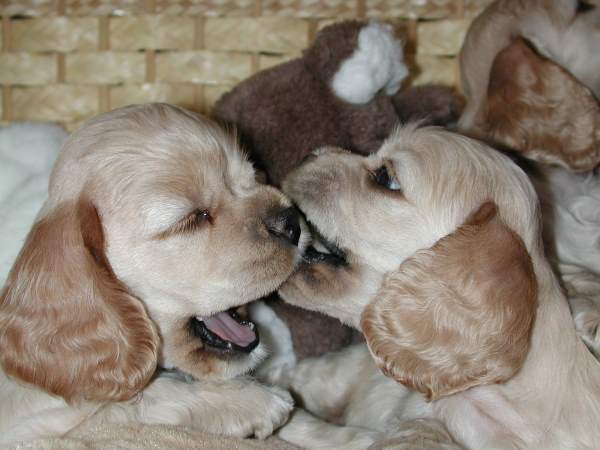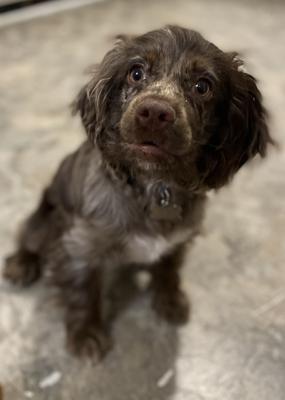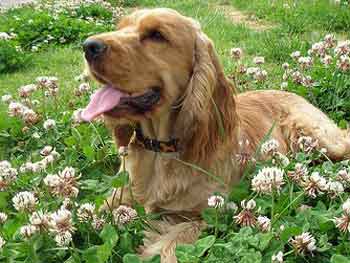- Home
- Cocker Spaniel training
- Food aggression in dogs
Food Aggression In Dogs
Food aggression in dogs is a situation which can be triggered if your Cocker feels his food is under threat. It can be very dangerous and frightening to see.
Learn how to spot the signs of dog food aggression and how to remedy this potentially dangerous aggressive dog behaviour!
Dog Food Aggression: What's It All About?
What's it all about?
Well...if your sweet, loving Cocker Spaniel suddenly turns into a snarling demon when anyone approaches his food bowl while he's eating, that's dog food aggression!
Your dog believes his food is going to be taken away from him (yes, even though you gave it to him) and he will do all he can to stop that from happening.
Food aggression in dogs (also known as 'resource guarding') is instinctive and it's normal canine behaviour.
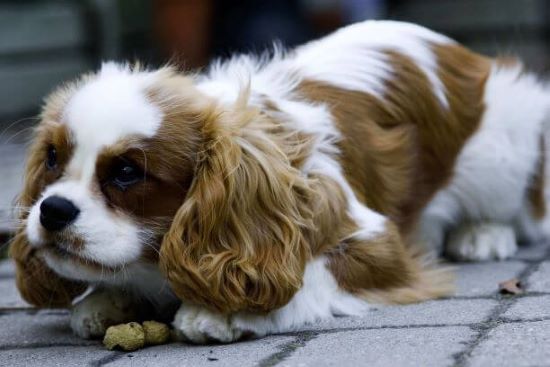 Don't touch my treat!
Don't touch my treat!It's a throw-back to the wild where dogs lived and hunted
in packs and could never be certain when or where their next meal was coming from.
They had to fight for their share of the 'spoils' and fiercely guarded their food as only the fittest and strongest dogs survived.
Today, our domesticated pets no longer have to forage for their food. We spoil them and they always know that they're not far from their next meal or a tasty treat!
However, this instinct can rear its ugly head from time to time (and you may think for no 'apparent' reason).
Dog food aggression is a potentially dangerous and (in our human world) unacceptable canine behaviour, and if it's not addressed swiftly your dog will almost certainly end up biting or attacking someone, resulting in a serious injury.
If you see signs that your Cocker Spaniel is beginning to guard his food or toys, I recommend you take swift action, and if you're not sure what those signs are, you'll find what you're looking for further down this page.
What Causes Food Aggression In Dogs?
There are many situations that may cause food aggression in dogs, but in
most cases it's either:
Threatened Removal Of Food:
Your dog's aggression may be triggered if he thinks you're going to take his food from him (even though you gave it to him in the first place!).
When he growls or snarls, he's giving you a very definite warning to stay away!
If you then remove his food from him you'll be making the problem worse because you'll have confirmed that he was right all along: you were going to steal his food!
Leadership Issues:
Food aggression in dogs may also be triggered where there's a question over leadership, for example, the owner relaxes his role as leader, the dog becomes aware of it and views the lapse as a weakness.
In a pack, (wild or domestic) members will usually compete with one another and the strongest will win the position of head of the pack.
All packs need a leader and if your Cocker sees a weakness in you he'll almost certainly try to assume the role of alpha male (which, by the way, could also be female, the term just means 'top dog or leader').
Your dog should never be allowed to 'run the show' and it's important that you quickly reclaim your status as pack leader if you are going to resolve your Cocker Spaniel's food aggression.
Learn more about the alpha dog and how to become the leader of your 'pack'.
Signs Of Food Aggression In Dogs & Puppies
The first signs of food aggression in dogs are subtle and very easily overlooked.
Early Signs of Dog Food Aggression
Some or all of the following signs may be seen if you approach your dog while he's eating, for example, he may:
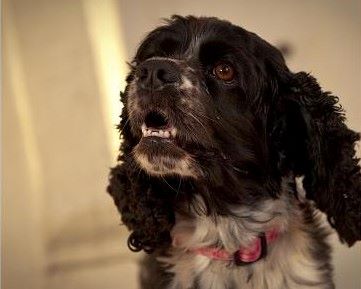 Stay away from my food!
Stay away from my food!- hold his head low,
- become very still and tense his muscles,
- begin to tremble,
- lower his tail,
- wag his tail very quickly (it's often difficult to distinguish this from normal happy tail wagging, but it's a tight, fast wag, not a relaxed swishing wag),
- stop eating when you get near him, his eyes following your every move,
- move his body between you and his food bowl to stop you from taking it.
If you notice any of these 'early warning signs', I recommend you nip it in the bud before it escalates.
The following are more obvious signs of food aggression in dogs and if left unaddressed, will become more difficult to resolve.
More Serious Signs of Food Aggression
As the resource guarding escalates, your dog may display other, more threatening signs. For example, he may:
- give a low warning growl,
- snarl (sometimes quite viciously) as you approach him,
- bark at you,
- snap at your hands,
- bite whoever approaches him,
- curl or lift his lip(s),
- hold his ears back,
- give you a hard, glassy stare,
- raise his hackles.
In a domestic environment, aggressive dog behaviours such as those listed above are unacceptable; they are very dangerous and must be addressed immediately.
IMPORTANT NOTE: Do not, under any circumstances, try to remove food from a dog displaying food aggression. If you do, you'll almost certainly get hurt.
How To Remedy Food Aggression In Dogs
Long before dogs became domesticated, the alpha male would always eat first.
To help you retain (or regain) the role of alpha dog, make sure you always feed your dog after you and your family have eaten.
At the very least, let your dog see you eat something, a cracker perhaps, or simply pretend to eat some of his food before you feed him.
Follow these recommended feeding guidelines, which will help to prevent food aggression in dogs, and then try one or more of the following remedies:
Method 1: Remedy For Food Aggression In Dogs
- Ask your dog to sit or lie down before you begin feeding him; always make him work for his food.
- Feed your dog by hand; don't let him eat from his bowl.
- After a few days of hand feeding introduce an empty bowl nearby and leave it empty.
- After
a couple of days of ignoring the empty bowl, gradually move it a little nearer during each
hand feeding. Take care not to rush this step as the sight of his food bowl could trigger his food aggression.
- At your next feeding session, move the food bowl directly underneath your hand, the one that's feeding your dog.
- If
that doesn't spook him, drop a piece of kibble into his dish and let
him eat it. Continue to hand feed him but drop an occasional piece of
kibble into his dish.
- Repeat this exercise at each mealtime for at least 3 days before going on to the next step.
- Gradually
increase the amount of kibble you drop into his bowl each time until
eventually his entire morning or evening meal is in his food bowl.
- Speak to Cocker as you're putting food into his bowl to help him associate your voice with his kibble dropping into the bowl.
- Continue to sit with him while he eats.
- As
your pet begins to accept you around him while he's eating,
and accepts you dropping titbits into his bowl, try stroking him gently. (I recommend you stroke his back and not his head at this stage, just until you're certain he won't bite you.)
- If he's comfortable with being stroked, continue
this during the following few mealtimes, but take it slowly so he doesn't
feel threatened.
- Children should be allowed to
drop food into your dog's bowl too, but only under strict adult supervision.
- If
your Cocker Spaniel is only aggressive to one member of your family, it might be a
good idea if that person takes on the role of feeding him for a while. Ideally though, it's best if all members of the family are involved with his mealtimes.
- If you have more than one dog, feed them separately, either in different parts of the
house or in their own crates, at least until the problem is fully
resolved.
- If, at any point, your dog begins
growling again, or shows any of the above signs of aggression, you've
probably moved on too quickly and will need to go back a few steps or
begin again, but this time working at a slower pace.
Method 2: Remedy For Food Aggression In Dogs
- Place your dog's empty bowl on the floor and step away from it.
- After
a few seconds, your dog will probably look at you as if to ask,
'Where's my dinner?' When he does, walk up to him and drop a few pieces
of kibble into his bowl, then walk away again.
- When he's eaten the kibble, he'll probably look to you to provide more food. As soon as he looks at you, feed him some more, in the same way.
- Continue this process until your dog has eaten all of his meal.
This
exercise will help to teach your Cocker Spaniel that you are the source of his
food and will help him to enjoy (and, more importantly, accept) you
approaching him and being around him while he's feeding.
Method 3: Remedy For Food Aggression In Dogs
The following method only applies if your puppy or dog is beginning to display early signs of dog food aggression and you are certain that your dog won't bite you. Removing food from an aggressive dog can result in serious injury.
If there's any doubt in your mind, do not try to take his food from him.
IMPORTANT: If using Method 3 results in your puppy missing more than one meal, I would change over to Method 1 because I'm not comfortable with a young puppy missing any more than one meal.
- Sit by your puppy while he feeds. Drop kibble into his bowl occasionally as he eats and stroke him gently. If your puppy shows any sign of dog food aggression during this time, remove his food bowl and replace it after 3 to 5 minutes.
- If he continues with the same
behaviour, remove the bowl again and
wait another 5 minutes.
- If he's still displaying aggression either when you approach him or when you're stroking him, remove his bowl altogether and try again at the next scheduled feeding time.
Your puppy will eventually learn that you are the provider of his food (but only when he
behaves) and that if he misbehaves you will remove it
and ultimately, he won't be fed.
Resource Guarding Toys
Resource guarding may be another name for food aggression in dogs but it isn't limited to food; your puppy may also guard his toys!
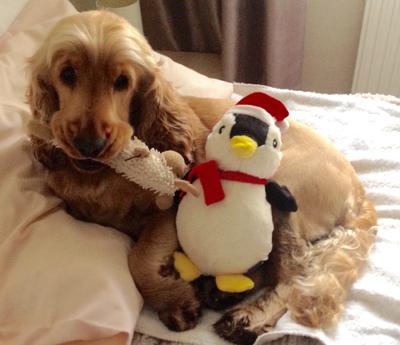 These are my favourite cuddly toys!
These are my favourite cuddly toys!To prevent this from happening, you may like to try the following exercise:
- Begin by giving your puppy a toy and let him play with it for a couple of minutes before gently taking it from him.
- Wait a couple of seconds, then give him a treat, praise him, and give the toy back to him to play with.
- Do this several times each day until your puppy readily gives up the toy when you take it from his mouth.
(If he runs away with the toy, don't chase him - you'll only be setting yourself up for trouble!)
Food Aggression In Dogs: A Word of Warning
Resolving food aggression in dogs is not easy nor is it a quick fix; it needs careful handling.
IMPORTANT:
Please do not attempt to remedy serious food aggression in dogs on your own. Always seek professional advice from your vet or a qualified dog behaviourist!
Food aggression should never be punished with harsh words.
And no matter how frustrated you are, please don't become aggressive yourself (verbally or, heaven forbid, physically) because this won't help.
Aggression from you will only make him much worse and the situation may spiral out of control as he responds to (and attempts to compete with) your aggression/retaliation.
Whilst it's possible to address food aggression in puppies and mild cases in dogs, I recommend you discuss your problem with either your vet or a dog behavioural specialist before attempting to treat any serious aggressive behaviours in dogs, particularly where you're worried that your pet may bite you.
If your Cocker
Spaniel is prone to resource guarding, you'll probably need to watch for
the reappearance of any warning signs of dog food aggression and
continue practising some of the above exercises from time to time,
probably for the rest of his life. In my opinion, it never really goes away.
Make a point of always being around your Cocker when he's eating and drop a couple of morsels of his favourite food into his bowl. Hopefully, this will help to reinforce in his mind that people approaching his dish mean that something good is about to happen and he shouldn't feel threatened.
Photo credits for Food Aggression in Dogs:
1. Holly Sisson - Has2006 at istock.com
2. Visitor photo
3. Visitor photo
